- 1. Key Takeaways
- 2. Features to Consider Before Purchasing a Flashlight
- 2.1. Size and Weight
- 2.2. Durability
- 2.3. Weather Resistance
- 2.4. Batteries
- 2.5. Beam
- 2.6. Runtime
- 2.7. Light Output (Lumens)
- 2.8. Brightness Levels
- 2.9. Light Modes
- 2.10. Charging Options
- 2.11. Price
- 3. Our Top Picks of Camping Flashlights
- 3.1. Fenix PD36R Pro Rechargeable Flashlight- Best Overall
- 3.2. Ledlenser MT14 1000 - Best for Runtime
- 3.3. ThruNite Archer 2A V3 - Budget AA Camp Flashlight
- 3.4. Kaito KA500- Best for Versatility
- 3.5. Nitecore EDC27 Flashlight- Best for Fast Charging
- 4. Why We Recommend Bringing a Flashlight
- 4.1. Lighting
- 4.2. To extend your phone’s battery life
- 4.3. Personal safety
- 5. Flashlight Alternatives
- 6. Final Thoughts
- 7. FAQs
- 7.1. How many lumens is a good flashlight for camping?
- 7.2. What flashlights do Navy Seals use?
- 7.3. Are Maglites good?
- 7.4. What is the best color for a flashlight?
- 7.5. Is it OK to leave a flashlight on all night?

KÜHL’s Best Camping Flashlight Picks for Overnight Travel
Table of Contents [Show]
When packing for a camping trip, the priority of your safety gear should come before everything else. A torch or flashlight is one such gear that should never miss a slot in any serious backpacker’s or hiker’s camping checklist. Why?
Because campsites don’t have yard lights, it’s nice to have a well-lit camp, so you don’t trip over a tent peg or the tree stump you didn’t see in the dark.
Today, a camp flashlight is not just a light source. You can also use it to deter a potential attacker and even signal for help during rescue ops.
Below, we break down important things to consider when choosing the best camping flashlight, like light output, runtime, and brightness levels. To complete your search, see our reviews of the best camping flashlights to buy this year!
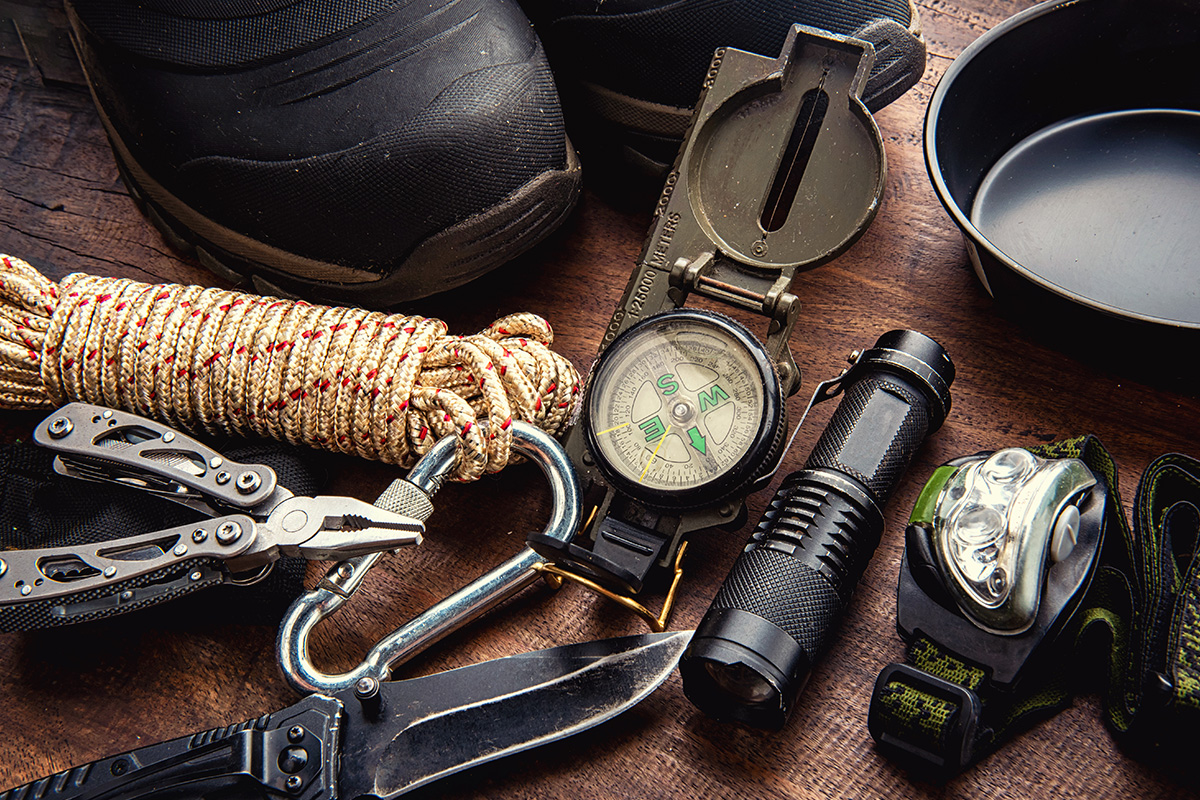
Key Takeaways
- A flashlight is more than just a light source. It’s a safety gear you can rely on to deter attackers and signal for help.
- Camping torches can carry larger batteries than headlamps, making them reliable as primary light sources.
- When buying a torch for camping, you should prioritize a longer runtime, weather resistance, and multiple light modes.
- While rechargeable flashlights are king, torches that use disposable batteries are easy to repower. You only need to bring an extra pack of batteries.
- The Fenix PD36R Pro is the best camping flashlight. It combines a high battery capacity with a high power output, a throw of up to 415 yards, five brightness levels, and strobe mode.
Features to Consider Before Purchasing a Flashlight
Size and Weight
Ideally, the best flashlight for camping should illuminate your trails and campsite while being easy to pack and carry around. Anticipate all the uses you plan to put it into to ensure its size and weight will allow.
Most standard flashlights can be considered hands-free and will fit in your pocket or hang on your keychain when not in use. Another benefit of a small torch is being able to clasp in your teeth when you need to use both hands.
Note: Most of a flashlight’s weight comes from its construction material and battery, which may affect durability and battery size. Consider what the flashlight is made of, its battery size, and run time when sizing it up.
Durability
Outdoor environments are harsh. From being rained on to being dropped on rocks and water paddles, you want a flashlight that won’t die on you when you badly need it.
Luckily, the best camp flashlight brands understand this concern and design products that can withstand these challenges. Flashlights engineered with durability in mind tend to cost more. But they can save you money on purchasing a new flashlight for every camping trip.
Consider flashlights made of anodized aluminum if durability is a priority. It’s tough, resistant to corrosion, and lighter than steel. Polycarbonate (PC) materials are worth considering if you are concerned more about the weight than a tough exterior.
Weather Resistance
It’s raining and dark outside. And you need to adjust that one-guy line at the back of the tent. Or, you have to hike a mile to your campsite in the dark when the skies decide to open up. These are some scenarios when you start worrying about your flashlight’s weather resistance.
Weather resistance in flashlights and other outdoor light sources is measured using the IPX rating system. The IPX scale ranges from IPX0, which means no protection at all, to IPX8. The latter means that the flashlight can survive being submerged in 1.5 meters of freshwater for up to 30 minutes.
Your ideal water-resistant flashlight’s rating will depend on the environment you plan to use it most. But for the most part, most campers do just fine with flashlights in the IP4 to IP7 range.
Batteries
The power source is a crucial consideration when comparing different flashlight camping options. And there are two things to consider here- battery type and battery life.
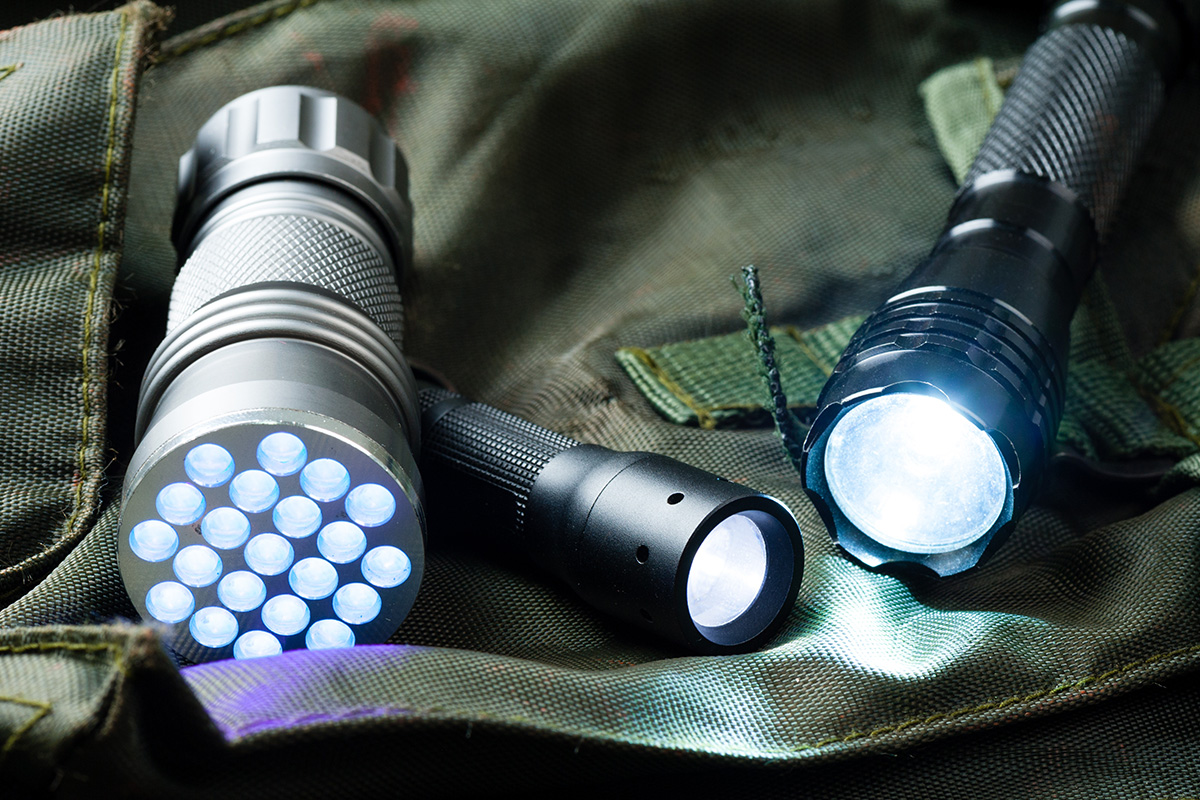
Types and Amount
In most cases, the number of batteries will impact the size and weight of the flashlight and runtime. And when it’s time for replacement, more batteries equate to more money.
You have two battery options when buying the best flashlight for camping: disposable and rechargeable batteries. Each battery type has its wins and losses, depending on the situation.
Disposable alkaline batteries- single-use AAA, AA, C, and D-size batteries are several folds cheaper than their rechargeable alternatives. Plus, they are readily available in almost any store. Outdoor enthusiasts who spend a week or two per trip will also argue that replacing a set of batteries is more convenient than charging.
On the flip side, flashlights that use alkaline batteries are generally dimmer. Though they are cheap, the cost of single-use batteries also tends to add up quickly, depending on type and usage. And they may not be the best option for an eco-conscious camper who minds their carbon footprint.
Rechargeable batteries- rechargeable Lithium-ion batteries may cost more than single-use batteries. But they are a cheaper option in the long run, thanks to their low ongoing cost. Another advantage of flashlights that use rechargeable li-ion batteries is their brighter kick compared to alkaline battery-based torches. Camping flashlights with a rechargeable battery get their juice from a portable power bank, laptop, your car’s cigarette charger, or a wall outlet.
Battery Life
A single-use battery is of no use once its charge has been drained. On the other hand, NiMH batteries last longer than alkaline batteries and are rechargeable using an external charge station. Rechargeable lithium-ion batteries have the longest lifespan because they boast a slower self-discharging rate.
Beam
Beam Type
A flashlight may have a broad beam, spot beam, or anything in between:
- A broad or flood beam illuminates a large area within a short distance. This beam type is ideal when you require sufficient light for your immediate surroundings, for instance, for some tasks around the camp or walking on the trail.
- A spot beam is a perfect solution when you need to light up a particular area or object over a long distance. A flashlight with this beam type will be useful when finding your route in the dark or discovering new caves.
- Combined beam- the best flashlights for camping have a 2-in-1 beam design allowing you to illuminate far and close areas. A camping torch with an adjustable beam is the best if you want to use it for various activities, be it reading a map or trail running early in the morning.
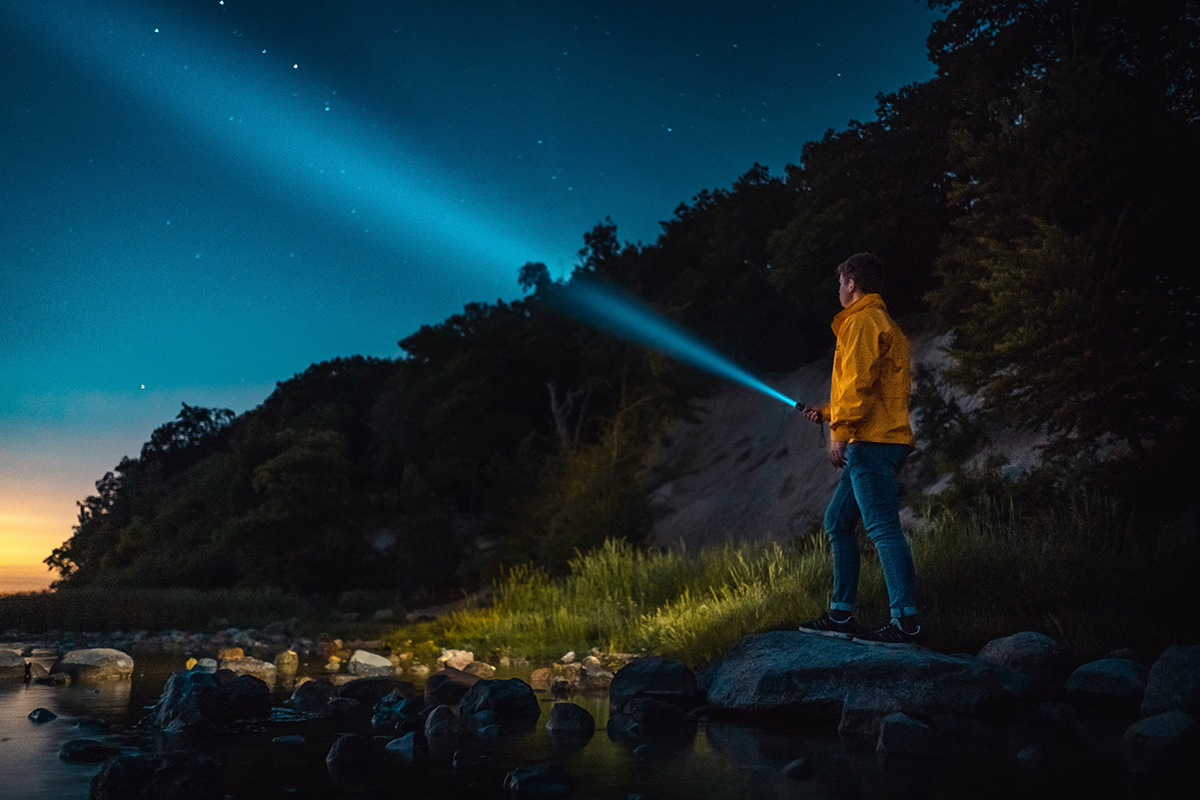
Beam Distance
Beam distance refers to how far the light beam travels before converging into full moonlight. The longer the beam distance, the further a flashlight can illuminate. Beam distance is determined by the brightness setting and the brightness of the LEDs.
Runtime
Runtime in flashlights refers to how long (in hours) the battery pack lasts before the need to recharge or replace the batteries. A flashlight’s runtime depends on its battery pack size and light output.
Generally speaking, a flashlight with a long runtime will always win another one with a shorter runtime. But remember, you can extend the battery’s runtime by choosing a lower brightness setting that meets your needs. Most of the flashlights in our list have runtimes between 1 and 42 hours.
Light Output (Lumens)
A flashlight’s brightness is measured in lumens. A flashlight with more lumens will typically be brighter than one with fewer lumens. But more lumens also mean that the batteries are used much faster. In other words, the flashlight with the most lumens is not always the best for everyone.
The average flashlight for everyday use emits about 100 lumens. We’ve seen some flashlights claiming to produce up to 200,000 lumens. But most of these figures are questionable and unnecessary for most people’s needs. A model with at least lumens will be ideal for use around your home and when camping.
Brightness Levels
The best camping flashlights have several brightness levels. While most models sport three brightness levels- low, med, and high- others have five or more brightness settings to meet all your camping light needs.
Light Modes
A camping flashlight can be more than a light source sometimes. Today’s best torches have several light modes, making them even more useful in specific circumstances.
Strobe Function
The strobe effect in flashlights produces intermittent light flashes that can disorient and blind a potential attacker. You can use it as a deterrent against an attacking bear, mountain lion, and even a person. Another use of the stroboscope mode is to signal motorists for help or attract others to your exact location during rescue operations.
Red Light
Red LED flashlights are commonly used in the military to preserve vision and lower soldiers’ light signatures. Likewise, if the typical white light tends to be harsh on your eyes when you suddenly switch it on, a red light flashlight may be a better option. Most animals cannot see the red color, which is why red light torches are also common among hunters. If you are camping or hiking in an area with wild animals, using a red light flashlight is less likely to startle them.
Charging Options
For flashlights with non-rechargeable batteries, check out whether a tool is needed to replace the batteries. If you are eyeing a rechargeable flashlight for camping, consider how it’s charged.
The new breed of rechargeable flashlights has an onboard USB port, which charges a battery pack inside. This allows you to charge the flashlight on the go from pretty much any USB power source, including power banks, laptops, and vehicles’ USB ports.
Some advanced models can also be solar-powered using an onboard solar panel. Others, like the Mesqool, have a built-in generator that produces electricity when you turn a hand crank. These are the best for prolonged winter camping. Having one in your first aid kit checklist for emergencies also pays.
Price
Flashlights range from budget models ($1-$20) to mid-range flashlights ($40-$75) and high-end flashlights (above $75).
An expensive flashlight does not always guarantee excellent quality, and a cheap model doesn’t mean low quality. But generally speaking, an expensive flashlight will always have the upper hand in terms of durability, brightness, runtime, and additional features, such as brightness levels and light modes.
Flashlights with rechargeable batteries, higher lumens, and longer runtimes tend to cost more. A strong impact- and weather resistance will also add to the cost.
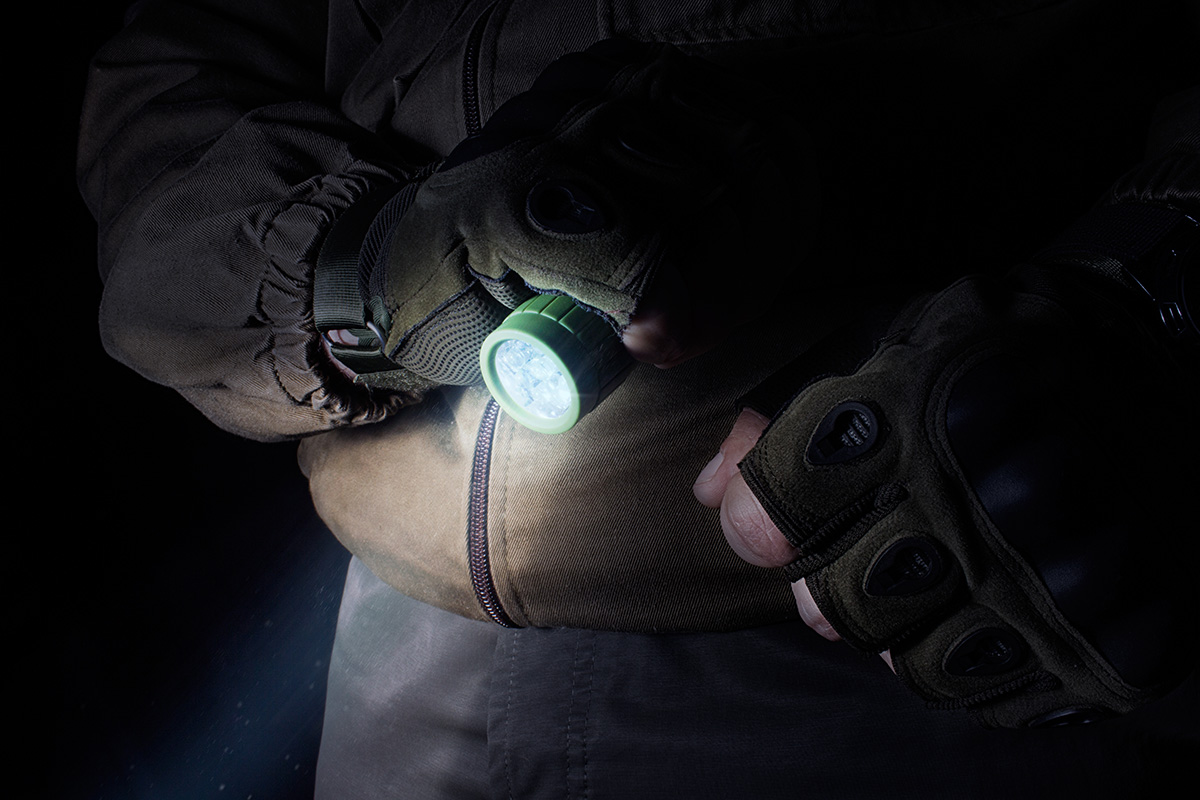
Our Top Picks of Camping Flashlights
Fenix PD36R Pro Rechargeable Flashlight- Best Overall
Fenix is arguably the best name in the world of flashlights because of its powerful, versatile, and durable lights. Our favorite model in their lineup is the Fenix PD36R Pro, which takes performance a notch higher compared to its predecessor, the oh-so-popular PD36R.
So, why does it top our best flashlight camping reviews? A lot of things! This handheld torch combines a bright beam of up to 2800 lumens with an impressive feature set, including a USB-C port for fast recharging, a dual tail switch for easy operations, and a pocket clip for easy everyday carry.
The Fenix PD36R Pro uses a 21700 5000 mAh battery and a Luminus SFT-70 LED. These two guarantee a high output and an impressive throw of up to 415 yards. You have five brightness levels to suit your different light needs, including eco (30 lumens), mid (350 lumens), and turbo (2800 lumens). It also has a strobe mode for defense against potential attackers and signaling for help.
The high-capacity battery takes a little longer to charge fully- 3 to 4 hours. But the PD36R Pro makes up for that with impressive runtimes of 3.5 hours to 42 hours, depending on brightness level.
All told the Fenix PD36R is a well-rounded work tool with no unnecessary fuss. Construction is typical Fenix quality- A6061-T6 aluminum coated in premium type III hard anodized finish. Its IP68 rating means it’s dust, dirt, and fall resistant and can withstand a total immersion of up to 6.5 feet for 30 minutes.
The Fenix PD36R has a length of 5.74”, a head diameter of 1.04”, a body diameter of 1.01”, and weighs 5.96 oz with the battery included.
Pros
- Perfect hand-size flashlight
- Fast charging with USB-C
- Extended runtime of up to 42 hours
- Multiple brightness levels, including strobe
- Intuitive controls
Cons
- The design does not allow tail standing
- One-way lens-down pocket clip
Ledlenser MT14 1000 - Best for Runtime
The Ledlenser MT14 has only three brightness levels, not five like the Fenix above. But if you care more about value than lighting modes, this is one of the best camping torches you can buy on Amazon today. And it’s almost $40 cheaper than the PD36R.
The Ledlenser MT14 LED flashlight is a one-handed operation. It uses a single button to cycle through its low, medium, and high brightness levels. One of its key selling points is its Rapid Focus System. This one-handed speed focus technology lets you focus and defocus the beam simply by moving the head of the torch in and out using your thumb.
This torch is powered by a rechargeable 26650 lithium-ion battery that takes approx 8 hours to charge fully using a micro-USB cable. From the highest setting, the Ledlenser MT14 offers a brightness level of 1000 lumens, a beam distance of 350 yards, and a runtime of 9 hours. The medium setting offers 200 lumens of brightness over a distance of about 130 yards and a 20-hour battery life. In eco mode, this flashlight provides 10 lumens of brightness, a beam distance of about 32 meters, and a runtime of 192 hours.
The MT14 LED flashlight is 5.9” long, 1.5” wide, and weighs around 8.9 ounces. It’s made of hard anodized aluminum and boasts a waterproof rating of IPX4. In other words, it’s splash-waterproof and resistant to light rain and dust particles.
Pros
- 2-way pocket clip
- One-hand operation
- Rapid focus system for crystal clear focusing
- Compact and solid construction
- Does not overheat
Cons
- Not fully waterproof
- It takes a long to charge fully (8 hours)
ThruNite Archer 2A V3 - Budget AA Camp Flashlight
We recommend the Thrunite Archer 2A V3 if you want a tough, old-school flashlight. We must agree that the V3 lacks the brightness and premium features that other pricier torches for camping in this list offer. But for around 50 bucks, this small and lightweight packs a decent punch and will undoubtedly impress most campers.
First thing first- this is an AA battery-powered flashlight. While rechargeable flashlights are the in-thing, a torch that uses replaceable AA batteries is a convenient addition to your arsenal for obvious reasons. Double A batteries are ubiquitous and easy to find. Another advantage is the ease of repowering. No more waiting for 3-8 hours for the battery to recharge.
The Thrunite Archer 2A V3 has a lumen output of 500 lumens over a beam distance of approx 102 yards. While it’s not the brightest in these camping flashlight reviews, the V3 will be sufficient for most campsite activities and illuminate the inside of your tent or sitting area. And because its flood is neutral light, you won’t be blasting your eyeballs when reading or making quick adjustments to your guy lines at night.
This little flashlight features dual switch operations. Use the tail switch to activate the light and the side switch to cycle through the five modes: firefly, low, medium, high, and strobe. The runtime ranges from 140 minutes in strobe mode to 28 days in firefly mode.
Build- and durability-wise, we are impressed. The Thrunite Archer 2A V3 is made of shockproof aluminum and has a reversible pocket clip. This flashlight is IPX8 rated, meaning it is drop-proof and waterproof.
Pros
- Easy to repower with disposable AA batteries
- Super lightweight at 1.7 ounces
- Dual switch operations
- Long battery life
- Waterproof and drop proof
Cons
- Comparably fewer lumens
- Not rechargeable
Kaito KA500- Best for Versatility
You can never be too careful, especially if you are planning to camp in low-use wilderness areas. The Kaito KA500 is a perfect tool that lets you tick off most of the boxes in your checklist while lightening your backpacking pack weight.
The KA500 is a 6-in-1 outdoor tool featuring a camping flashlight, camp table lamp, phone charger, SOS alarm, NOAA weather alert radio, and FM radio. This multipurpose safety and survival equipment sports a 600mAh rechargeable Ni-MH battery pack to support these functions.
We are great fans of its versatility in terms of repowering, too. You can charge the internal battery via an optional AC adapter, USB cable, the onboard 180-degree adjustable solar panel, and a dynamo crank. And when everything else fails, there is a triple-A battery compartment to keep it powered up.
Regarding its flashlight mode, the Kaito KA500 is bright to light up your trails and the area around the campsite. We also like its bright reading lamp, which can be used as a floodlight.
Pros
- A multipurpose 6-in-1 tool, including a flashlight, FM radio, and emergency alert radio
- Compact and lightweight for its versatility
- Multiple charging options
- It works even when the battery is dead, thanks to its hand crank
Cons
- Heavier than other flashlights on this list
Nitecore EDC27 Flashlight- Best for Fast Charging
Right off the bat, it’s easy to tell that the Nitecore EDC27 is a high-end piece of equipment. And it packs quite a punch at a great price. This flashlight’s center of attraction is its flat, slim design, which you may love or hate, depending on how you look at it.
On the plus side, this form factor prevents the torch from rolling off wherever you set it down. Its slim design also means it occupies minimal space inside your backpack or pocket while being easy to draw. Unfortunately, this design also means that the Nitecore EDC27 cannot tail-stand.
The Nitecore EDC27 is a powerful flashlight with two LEDs that max at 3000 lumens. It has two switches located at the back- a power ON/OFF button and a mode button. There are five brightness levels to choose from: ultralow (15 lumens), low (65 lumens), medium (200 lumens), high (1000 lumens), and turbo (3000 lumens). This flashlight also comes strobe mode-ready.
As for battery size, the Nitecore EDC27 uses a built-in 1700-milliamp battery. This gives you a runtime of 1h 45 minutes in high, 3h 45 mins in the medium setting, and up to 11 hours in low. The Nitecore EDC27 comes with a USB A to C charging cable, but you can also use your C to C to charge it fully in 75 minutes.
The Nitecore EDC27 is 5.34” long, 1.24” wide, and weighs 4.37 oz (battery included). Its housing is made of durable stainless steel coated with titanium-colored PVD. It has an IP54 rating, meaning it can withstand water sprays from all directions.
Pros
- Supports rapid charging (zero to full in 75 minutes)
- Slim and flat design for easy packability and placement
- Stylish design
- Multiple light modes (some are lockable)
Cons
- Can’t stand on its tail
- It gets hot in turbo mode
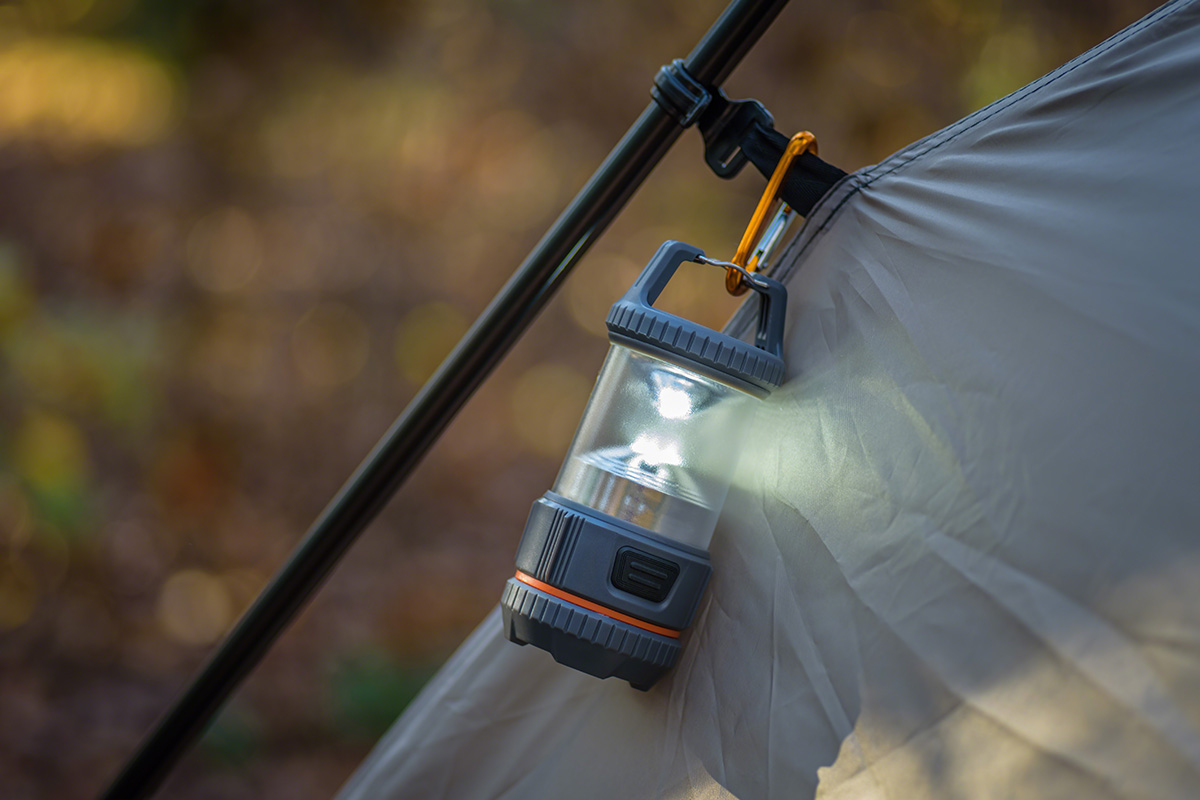
Why We Recommend Bringing a Flashlight
Lighting
The most obvious reason for bringing a camping torch is to be able to see once the sun goes down. A flashlight with adjustable brightness levels can be used for various camping activities, from setting up camp to cooking and reading.
To extend your phone’s battery life
When hiking in the darkness, a flashlight can light up the trail instead of draining your mobile phone’s battery.
Personal safety
Today’s camping flashlights are integrated with features such as strobe mode and red light. The strobe mode can help temporarily blind and disorient a potential attacker giving you an edge to escape. A flashlight with red light is ideal for minimizing your light profile and reducing the chance of startling wild animals.
Flashlight Alternatives
Camping flashlights are the most ubiquitous camp light solution among backpackers. But the market is flush with several other oft-overlooked flashlights camping alternatives:
- Headlamps- these will come in handy in tricky camping situations that require using two hands, from pitching the tent to cooking and night skiing.
- Camping lanterns- great to have when car camping; these are an excellent alternative to flashlights because of their soft, warm, and unobtrusive glow. These are the best if you want 360-degree illumination around the campsite.
- Camping string lights- like camping lanterns, you can rely on string lights around the camp as your primary light source. But their unique selling point is improving the ambiance of your setting, especially when dispersed camping in areas that are not too lit.
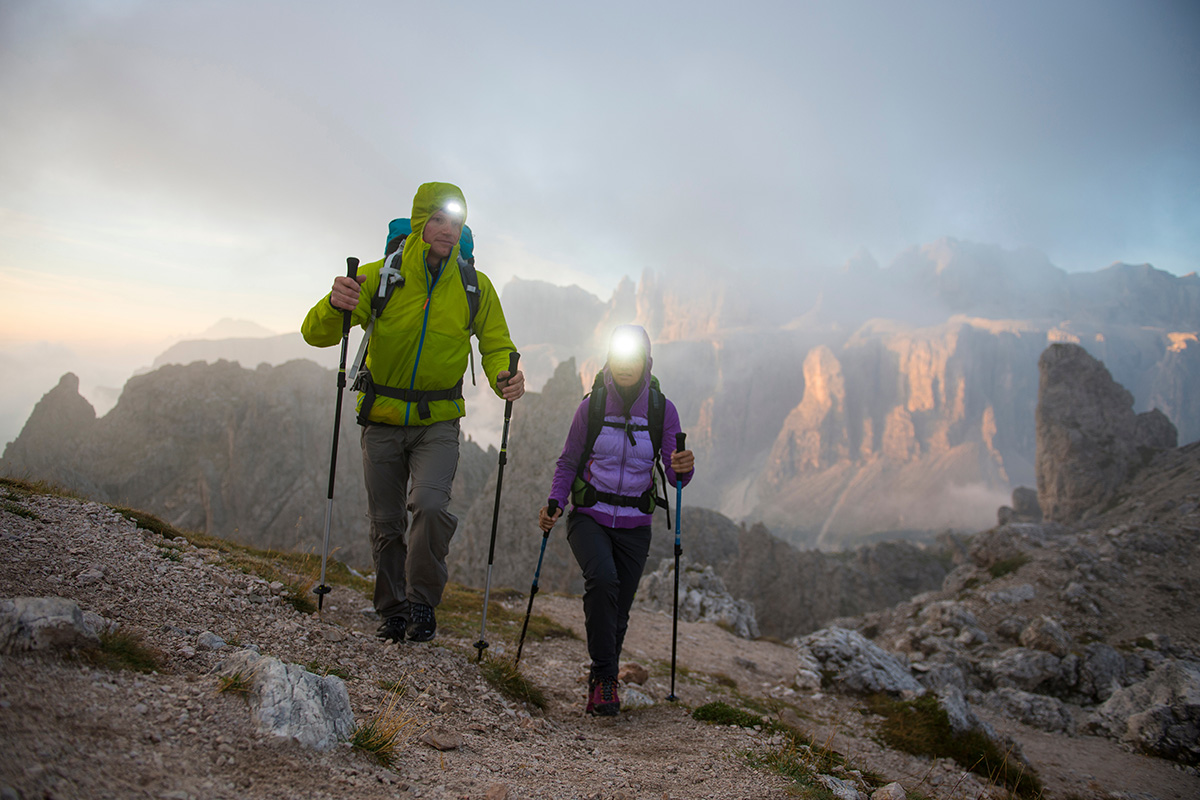
Final Thoughts
No matter where your camping spirit takes you, a flashlight is a trusty companion, particularly in terms of safety. Your pick from our recommendations above will narrow down to your budget and specific light needs.
But for serious outdoor use, remember to prioritize a camping flashlight with a higher light output, adjustable brightness levels, an extended runtime, and strobe mode. On top of everything, ensure it’s a flashlight that will hold on through the rain, light splashes, and a few drops here and there.
Featured image by: Ivan.
FAQs
How many lumens is a good flashlight for camping?
A flashlight with at least 200 lumens should be sufficient for most camping activities, from hiking the last mile to pitching the tent and cooking.
What flashlights do Navy Seals use?
The Navy Seals, the Coast Guard, and the Police use tactical flashlights. These are different from typical flashlights in that they can also be used for self-defense.
Are Maglites good?
If you can overlook their bulky and heavy design, Maglites still reign supreme in terms of reliability and durability.
What is the best color for a flashlight?
Cool white and neutral white are the most common colors for flashlights. The difference between them is that cool white contains more blue light, which is why they tend to overstimulate the eyes. On the other hand, neutral white tends to lean more towards daylight, which is generally easier on the eyes.
Is it OK to leave a flashlight on all night?
You could leave your flashlight on all night without a problem with the LEDs. But doing this will definitely increase battery drain, leading to shorter runtimes.


